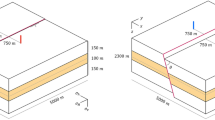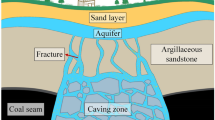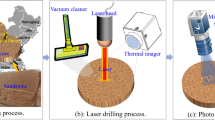Abstract
Numerical modeling of geochemistry associated with geologic CO2 storage involves many conceptual and quantitative uncertainties. In this study, a time efficient arbitrary polynomial chaos (aPC) expansion approach was proposed to do global sensitivity analysis of mineral dissolution and precipitation modeling in geologic carbon storage scenarios. To demonstrate the workflow of the aPC approach, a numerical model to predict permeability evolution of a Lower Tuscaloosa sandstone core exposed to CO2 saturated brine was used. The modeled sandstone core permeability by the aPC approach was 2095.5 mD ± 504.5 mD after 180 days of CO2 exposure. The measured permeability of the core after 180 days of CO2 exposure was 1925.0 mD, which was within the uncertainty range. Keq (SiO2 (am)) was the most important modeling parameter that influenced permeability results, implying that SiO2 (am) is a key mineral that governs permeability evolution of sandstone in geologic carbon storage scenarios. The aPC approach can reduce 99% of simulation time needed to do global sensitivity analysis of a complicated geochemical model, compared with traditional Monte Carlo approach.
Similar content being viewed by others
References
Allen, M.R., Frame, D.J., Huntingford, C., Jones, C.D., Lowe, J.A., Meinshausen, M., Meinshausen, N.: Warming caused by cumulative carbon emissions towards the trillionth tonne. Nature. 458(7242), 1163–1166 (2009)
Arrhenius, S.: XXXI. On the influence of carbonic acid in the air upon the temperature of the ground. The London, Edinburgh, and Dublin Philosophical Magazine and Journal of Science. 41(251), 237–276 (1896)
GISTEMP Team. GISS surface temperature analysis (GISTEMP). NASA Goddard Institute for Space Studies. Dataset accessed 2016-01-31 at http://data.giss.nasa.gov/gistemp/
Hansen, J., Ruedy, R., Sato, M., Lo, K.: Global surface temperature change. Rev. Geophys. 48, RG4004 (2010). https://doi.org/10.1029/2010RG000345
Lacis, A.A., Schmidt, G.A., Rind, D., Ruedy, R.A.: Atmospheric CO2: principal control knob governing Earth’s temperature. Science. 330(6002), 356–359 (2010)
Metz, B., Davidson, O., De Coninck, H., Loos, M., Meyer, L.: IPCC special report on carbon dioxide capture and storage.Intergovernmental Panel on Climate Change. Working Group III, Geneva (2005)
Raupach, M.R., Marland, G., Ciais, P., Le Quéré, C., Canadell, J.G., Klepper, G., Field, C.B.: Global and regional drivers of accelerating CO2 emissions. Proc. Nat. Acad. Sci. 104(24), 10288–10293 (2007)
Solomon, S., Plattner, G.K., Knutti, R., Friedlingstein, P.: Irreversible climate change due to carbon dioxide emissions. Proc. Nat. Acad. Sci. 106(6), 1704–1709 (2009)
Liu, H., Were, P., Li, Q., Gou, Y., Hou, Z.: Worldwide status of CCUS technologies and their development and challenges in China. Geofluids. 1–25 (2017)
Carroll, S., Carey, J.W., Dzombak, D., Huerta, N.J., Li, L., Richard, T., Um, W., Walsh, S.D., Zhang, L.: Role of chemistry, mechanics, and transport on well integrity in CO2 storage environments. Int. J. Greenhouse Gas Control. 49, 149–160 (2016)
Cheng, X.W., Mei, K.Y., Li, Z.Y., Zhang, X.G., Guo, X.Y.: Research on the interface structure during unidirectional corrosion for oil-well cement in H2S based on computed tomography technology. Ind. Eng. Chem. Res. 55(41), 10889–10895 (2016)
Hosseini, S.A., Lashgari, H., Choi, J.W., Nicot, J.P., Lu, J., Hovorka, S.D.: Static and dynamic reservoir modeling for geological CO2 sequestration at Cranfield, Mississippi, USA. Int. J. Greenhouse Gas Control. 18, 449–462 (2013)
Jun, Y.S., Giammar, D.E., Werth, C.J.: Impacts of geochemical reactions on geologic carbon sequestration. Environ. Sci. Technol. 47(1), 3–8 (2013)
Namhata, A., Zhang, L., Dilmore, R.M., Oladyshkin, S., Nakles, D.V.: Modeling changes in pressure due to migration of fluids into the above zone monitoring interval of a geologic carbon storage site. Int. J. Greenhouse Gas Control. 2017(56), 30–42 (2017)
Nordbotten, J.M., Celia, M.A., Bachu, S.: Injection and storage of CO2 in deep saline aquifers: analytical solution for CO2 plume evolution during injection. Transp. Porous Media. 58(3), 339–360 (2005)
Oldenburg, C.M., Pruess, K., Benson, S.M.: Process modeling of CO2 injection into natural gas reservoirs for carbon sequestration and enhanced gas recovery. Energy Fuel. 15(2), 293–298 (2001)
Trevisan, L., Pini, R., Cihan, A., Birkholzer, J.T., Zhou, Q.L., Gonzalez-Nicolas, A., Illangasekare, T.H.: Imaging and quantification of spreading and trapping of carbon dioxide in saline aquifers using meter-scale laboratory experiments. Water Resour. Res. 53(1), 485–502 (2017)
Xu, T., Apps, J.A., Pruess, K.: Mineral sequestration of carbon dioxide in a sandstone–shale system. Chem. Geol. 217(3), 295–318 (2005)
Yang, D.S., Wang, W., Chen, W.Z., Yang, J.P., Wang, S.G.: Investigation on stress sensitivity of permeability in a natural fractured shale. Environ. Earth Sci. 78, 1–10 (2019a). https://doi.org/10.1007/s12665-019-8045-2
Yang, Y., Yang, H., Liu, T., Yao, J., Wang, W., Zhang, K., Luquot, L.: Microscopic determination of remaining oil distribution in sandstones with different permeability scales using computed tomography scanning. J. Energy Res. Technol. 141, 092903–092901 (2019b)
Zhang, L., Dilmore, R.M., Bromhal, G.S.: Effect of outer boundary condition, reservoir size, and CO2 effective permeability on pressure and CO2 saturation predictions under carbon sequestration conditions. Greenhouse Gases Sci. Technol. 6(4), 546–560 (2016)
Pruess, K., Garcia, J.: Multiphase flow dynamics during CO2 disposal into saline aquifers. Environmental Geology. 42(2-3), 282–295 (2002)
Rutqvist, J., Tsang, C.F.: A study of caprock hydromechanical changes associated with CO2-injection into a brine formation. Environmental Geology. 42(2-3), 296–305 (2002)
Damen, K., Faaij, A., Turkenburg, W.: Health, safety and environmental risks of underground CO2 storage–overview of mechanisms and current knowledge. Climatic Change. 74(1-3), 289–318 (2006)
Jones, D.J., Beaubien, S.E., Annunziatellis, A., Baubron, J.C., Braubant, G., Cardellini, C., Cinti, D., Scheib, C., Lombardi, S., Michel, K, Morgantini, N.: Surface gas measurements and related studies for the characterization and monitoring of geological CO2 storage sites; experiences at Weyburn and in Salah. In Proceedings of CO2CS International Symposium, Berkeley, California (USA), 20-22 Marzo 2006. 169–172 (2006)
Voltattorni, N., Caramanna, G., Cinti, D., Galli, G., Pizzino, L. and Quattrocchi, F.: Study of natural CO2 emissions in different Italian geological scenarios. In Advances in the geological storage of carbon dioxide (pp. 175–190) (2006). Springer, Dordrecht. https://link.springer.com/chapter/10.1007/1-4020-4471-2_15
Cantucci, B., Montegrossi, G., Vaselli, O., Tassi, F., Quattrocchi, F., Perkins, E.H.: Geochemical modeling of CO2 storage in deep reservoirs: The Weyburn Project (Canada) case study. Chem. Geol. 265(1–2), 181–197 (2009)
Zhang, L., Dilmore, R., Namhata, A., Bromhal, G.: Feasibility of CO2 migration detection using pressure and CO2 saturation monitoring above an imperfect primary seal of a geologic CO2 storage formation: a numerical investigation. Comput. Geosci. 22(3), 909–923 (2018)
Allen, D.E., Strazisar, B.R., Soong, Y., Hedges, S.W.: Modeling carbon dioxide sequestration in saline aquifer: significance of elevated pressures and salinities. Fuel Process. Technol. 86, 1569–1580 (2005)
Luquot, L., Gouze, P.: Experimental determination of porosity and permeability changes induced by injection of CO2 into carbonate rocks. Chemical Geology. 265(1-2), 148–159 (2009)
Farquhar, S.M., Dawson, G.K.W., Esterle, J.S., Golding, S.D.: Mineralogical characterisation of a potential reservoir system for CO2 sequestration in the Surat Basin. Australian Journal of Earth Sciences. 60(1), 91–110 (2013)
Bacon, D.H., Dai, Z., Zheng, L.: Geochemical impacts of carbon dioxide, brine, trace metal and organic leakage into an unconfined, oxidizing limestone aquifer. Energy Procedia. 63, 4684–4707 (2014)
Luhmann, A.J., Kong, X.Z., Tutolo, B.M., Garapati, N., Bagley, B.C., Saar, M.O., Seyfried Jr., W.E.: Experimental dissolution of dolomite by CO2-charged brine at 100 C and 150 bar: Evolution of porosity, permeability, and reactive surface area. Chemical Geology. 380, 145–160 (2014)
Gislason, S., Broecker, W., Gunnlaugsson, E., Snaebjornsdottir, S., Mesfin, K., Alfredsson, H., Aradóttir, E., Sigfusson, B., Gunnarsson, I., Stute, M., Matter, J.: Rapid solubility and mineral storage of CO2 in basalt. Energy Procedia. 63(63), 4561–4574 (2014)
Yang, C., Hovorka, S.D., Treviño, R.H., Delgado-Alonso, J.: Integrated framework for assessing impacts of CO2 leakage on groundwater quality and monitoring-network efficiency: case study at a CO2 enhanced oil recovery site. Environmental Science & Technology, 49(14), 8887–8898 (2015a)
Yang, C., Treviño, R.H., Hovorka, S.D., Delgado-Alonso, J. Semi-analytical approach to reactive transport of CO2 leakage into aquifers at carbon sequestration sites. Greenhouse Gases: Science and Technology, 5(6), 786–801 (2015b)
Zhang, L., Soong, Y., Dilmore, R., Lopano, C.: Numerical simulation of porosity and permeability evolution of mount Simon sandstone under geological carbon sequestration conditions. Chem. Geol. 403, 1–12 (2015)
Miller, Q.R., Wang, X., Kaszuba, J.P., Mouzakis, K.M., Navarre-Sitchler, A.K., Alvarado, V., McCray, J.E., Rother, G., Bañuelos, J.L., Heath, J.E.: Experimental study of porosity changes in shale caprocks exposed to carbon dioxide-saturated brine II: Insights from aqueous geochemistry. Environmental Engineering Science. 33(10), 736–744 (2016)
Saltelli, A., Ratto, M., Andres, T.: Global Sensitivity Analysis: The Primer. Wiley (2008)
Sobol, I.: Global sensitivity indices for nonlinear mathematical models and their Monte Carlo estimates. Math. Comput. Simul. 55, 271–280 (2001)
Ashraf, M., Oladyshkin, S., Nowak, W.: Geological storage of CO2: global sensitivity analysis and risk assessment using arbitrary polynomial chaos expansion. Int. J. Greenhouse Gas Control. 19, 704–719 (2013)
Oladyshkin, S., de Barros, F.P.J., Nowak, W.: Global sensitivity analysis: a flexible and efficient framework with an example from stochastic hydrogeology. Adv. Water Resour. 37, 10–22 (2012)
Devenish, B.J., Francis, P.N., Johnson, B.T., Sparks, R.S.J., Thomson, D.J.: Sensitivity analysis of dispersion modeling of volcanic ash from Eyjafjallajökull in may 2010. J. Geophys. Res. 117, 309–315 (2012)
Pianosi, F., Beven, K., Freer, J., Hall, J.W., Rougier, J., Stephenson, D.B., Wagener, T.: Sensitivity analysis of environmental models: A systematic review with practical workflow. Environ. Model. Softw. 79, 214–232 (2016)
Steefel, C.I., Lasaga, A.C.: A coupled model for transport of multiple chemical-species and kinetic precipitation dissolution reactions with application to reactive flow in single-phase hydrothermal systems. Am. J. Sci. 294(5), 529–592 (1994)
Carroll, S.A., McNab, W.W., Dai, Z., Torres, S.C.: Reactivity of mount Simon sandstone and the Eau Claire shale under CO2 storage conditions. Environ. Sci. Technol. 47(1), 252–261 (2012)
Wolery, T.J.: EQ3/6: Software package for geochemical modeling of aqueous systems: Package overview and installation guide (version 7.0). Lawrence Livermore National Laboratory Report UCRL-MA-110662 PT I, Livermore, California (1992)
Marty, N.C., Tournassat, C., Burnol, A., Giffaut, E., Gaucher, E.C.: Influence of reaction kinetics and mesh refinement on the numerical modelling of concrete/clay interactions. J. Hydrol. 364(1–2), 58–72 (2009)
Wersin, P., Johnson, L.H., Schwyn, B.: Assessment of redox conditions in the near field of nuclear waste repositories: application to the Swiss high-level and intermediate level waste disposal concept. MRS Online Proc. Libr. Arch. 807, 539–544 (2003)
Castendyk, D.N., Webster-Brown, J.G.: Sensitivity analyses in pit lake prediction, Martha mine, New Zealand 2: geochemistry, water–rock reactions, and surface adsorption. Chem. Geol. 244(1–2), 56–73 (2007)
De Windt, L., Chaurand, P., Rose, J.: Kinetics of steel slag leaching: batch tests and modeling. Waste Manage. 31(2), 225–235 (2011)
Ciffroy, P., Benedetti, M.: A comprehensive probabilistic approach for integrating natural variability and parametric uncertainty in the prediction of trace metals speciation in surface waters. Environ. Pollut. 242, 1087–1097 (2018)
Ceriotti, G., Guadagnini, L., Porta, G., Guadagnini, A.: Local and global sensitivity analysis of Cr (VI) Geogenic leakage under uncertain environmental conditions. Water Resour. Res. 54(8), 5785–5802 (2018)
Eldred, E.S.; Burkardt, J.: Comparison of non-intrusive polynomial chaos and stochastic collocation methods for uncertainty quantification. 47th AIAA Aerospace Sciences Meeting including the New Horizons Forum and Aerospace Exposition, Orlando, FL, 2009, January 5–8, AIAA paper 2009–0976
Li, H., Zhang, D.: Probabilistic collocation method for flow in porous media: comparisons with other stochastic methods. Water Resour. Res. 43, 44–56 (2007)
Xiu, D., Karniadakis, G.E.: Modeling uncertainty in flow simulations via generalized polynomial chaos. J. Comput. Phys. 187, 137–167 (2003)
Zhang, Y., Sahinidis, N.V.: Uncertainty Quantification in CO2 Sequestration Using Surrogate Models from Polynomial Chaos Expansion. Ind. Eng. Chem. Res. 52(9), (2013)
Oladyshkin, S., Class, H., Helmig, R., Nowak, W.: A concept for data driven uncertainty quantification and its application to carbon dioxide storage in geological formations. Adv. Water Resour. 34, 1508–1518 (2011a)
Oladyshkin, S., Nowak, W.: Date-driven uncertainty quantification using the arbitrary polynomial chaos expansion. Reliab. Eng. Syst. Saf. 106, 179–190 (2012)
Wiener, N.: The homogeneous chaos. Am. J. Math. 1938(60), 897–936 (1938)
Namhata, A., Oladyshkin, S., Dilmore, R.M., Zhang, L., Nakles, D.V.: Probabilistic assessment of above zone pressure predictions at a geologic carbon storage site. Sci. Rep. 6, 39536 (2016)
Oladyshkin, S., Class, H., Helmig, R., Nowak, W.: An integrative approach to robust design and probabilistic risk assessment for storage in geological formations. Comput. Geosci. 15, 565–577 (2011b)
Oladyshkin, S., Class, H., Helmig, R., Nowak, W.: Highly Efficient Tool for Probabilistic Risk Assessment of Ccs Joint with Injection Design, Computational Methods in Water Resources (CMWR). XVIII International Conference on Water Resources, Barcelona (2010)
Crestaux, T., Le Maitre, O., Martinez, J.M.: Polynomial chaos expansion for sensitivity analysis. Reliability Engineering & System Safety. 94(7), 1161–1172 (2009)
Sudret, B.: Global sensitivity analysis using polynomial chaos expansions. Reliability Engineering & System Safety. 93(7), 964–979 (2008)
Sobol, I.M.: On sensitivity estimation for nonlinear mathematical models. Math. Model. 2(1), 112–118 (1990)
Maltz, F.H., Hitzl, D.L.: Variance reduction in Monte Carlo computations using multi-dimensional hermite polynomials. J. Comput. Phys. 2, 345–376 (1979)
Robert, C.P., Casella, G.: Monte Carlo Methods. Springer, New York (2004)
Oladyshkin, S., Schröder, P., Class, H., Nowak, W.: Chaos expansion based bootstrap filter to calibrate CO2 injection models. Energy Procedia. 40, 398–407 (2013)
Zhang, L., Soong, Y., Dilmore, R.M.: Numerical investigation of lower Tuscaloosa sandstone and Selma chalk caprock under geological CO2 sequestration conditions: mineral precipitation and permeability evolution. Greenhouse Gases Sci. Technol. 7(6), 988–1007 (2017)
Singh, H., Srinivasan, S.: Scale up of reactive processes in heterogeneous media-numerical experiments and semi-analytical modeling. In SPE Improved Oil Recovery Symposium. Society of Petroleum Engineers (2014)
Carroll, S.A., McNab, W.W., Dai, Z., Torres, S.C.: Reactivity of Mount Simon sandstone and the Eau Claire shale under CO2 storage conditions. Environmental Science & Technology. 47(1), 252–261 (2013)
Steefel, C.I.: CrunchFlow User’s Manual. Lawrence Berkeley National Laboratory, Berkeley (2009)
Li, L., Steefel, C.I., Kowalsky, M.B., Englert, A., Hubbard, S.S.: Effects of physical and geochemical heterogeneities on mineral transformation and biomass accumulation during a biostimulation experiment at rifle, Colorado. J. Contam. Hydrol. 112, 45–63 (2010)
Li, L., Gawande, N., Kowalsky, M.B., Steefel, C.I., Hubbard, S.S.: Physicochemical heterogeneity controls on uranium bioreduction rates at the field scale. Environ. Sci. Technol. 45, 9959–9966 (2011)
Beckingham, L., Qin, F.: Impact of image resolution on quantification of mineral properties and simulated mineral reactions and reaction rates. Presented at InterPore 11th Annual Meeting, Valencia, Spain, 6–10 May, 2019
Kampman, N., Bickle, M., Wigley, M., Dubacq, B.: Fluid flow and CO2-fluid-mineral interactions during CO2-storage in sedimentary basins. Chem. Geol. 369, 22–50 (2014)
De Silva, G.P.D., Ranjith, P.G., Perera, M.S.A.: Geochemical aspects of CO2 sequestration in deep saline aquifers: a review. Fuel. 155, 128–143 (2015)
Ciriello, V., Lauriola, I., Tartakovsky, D.M.: Distribution-based global sensitivity analysis in hydrology. Water Resour. Res. 55(11), 8708–8720 (2019)
Acknowledgments
This work is supported by the Thousand Talent Program for Outstanding Young Scientists (Y731101B01), the National Natural Science Foundation of China projects (41902258 and U1967208), and CAS-ITRI collaborative research funding (CAS-ITRI2019011). The authors would like to acknowledge Dr. Sergey Oladyshkin at the University of Stuttgart for allowing us to use the aPC analysis code, and Dr. Zan Wang at the NETL for her advice in improving the manuscript.
Author information
Authors and Affiliations
Corresponding author
Additional information
Publisher’s note
Springer Nature remains neutral with regard to jurisdictional claims in published maps and institutional affiliations.
Rights and permissions
About this article
Cite this article
Zhang, L., Namhata, A., Dilmore, R. et al. Application of arbitrary polynomial chaos (aPC) expansion for global sensitivity analysis of mineral dissolution and precipitation modeling under geologic carbon storage conditions. Comput Geosci 24, 1333–1346 (2020). https://doi.org/10.1007/s10596-020-09953-6
Received:
Accepted:
Published:
Issue Date:
DOI: https://doi.org/10.1007/s10596-020-09953-6




